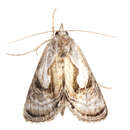Conservation Status
provided by University of Alberta Museums
At the western edge of the range in Alberta. No concerns.
- license
- cc-by-nc
- copyright
- University of Alberta Museums
Cyclicity
provided by University of Alberta Museums
Adults are on the wing in Alberta in July and early August.
- license
- cc-by-nc
- copyright
- University of Alberta Museums
Distribution
provided by University of Alberta Museums
From Newfoundland west across the southern boreal forest to central and northern Alberta, south to Maryland, Kentucky and North Carolina. In Alberta, it has been collected in the Boreal forest in the eastern half of the province, from the Edmonton area north to Lake Athabasca.
- license
- cc-by-nc
- copyright
- University of Alberta Museums
General Description
provided by University of Alberta Museums
A medium-size (3.0-3.5 cm. wingspan) moth with pale grey (sometimes with a pinkbrown tint) forewings and dark hindwings. The forewing pattern is unusual and unmistakable. A wide, dirty white swath runs in an arc from the wing base along the leading edge to about mid-wing, with the area below this grey-brown. The outer half of the forewing has a series of narrow wavy bands of black, dark grey-brown, and brown shading into a broad subterminal pale grey band and a narrow blackish terminal band followed by fine pale and dark grey bands. Hindwings are dark smoky brown, faintly banded and slightly darkening toward the outer margin. The antennae are simple, and both the sexes are similar.
- license
- cc-by-nc
- copyright
- University of Alberta Museums
Habitat
provided by University of Alberta Museums
Sandy jackpine forest and other well-drained boreal woodlands.
- license
- cc-by-nc
- copyright
- University of Alberta Museums
Life Cycle
provided by University of Alberta Museums
The adults are nocturnal and come to light. There is a single brood each year
- license
- cc-by-nc
- copyright
- University of Alberta Museums
Trophic Strategy
provided by University of Alberta Museums
No Alberta data. Elsewhere, the larvae are reported to feed on Blueberry (Vaccinium sp.) and Huckleberry (Gaylussacia sp.), both in the family, Ericaceae.
- license
- cc-by-nc
- copyright
- University of Alberta Museums
Chrysanympha formosa
provided by wikipedia EN
- license
- cc-by-sa-3.0
- copyright
- Wikipedia authors and editors
Chrysanympha formosa: Brief Summary
provided by wikipedia EN
Chrysanympha formosa, the Formosa looper, is a moth of the family Noctuidae. The species was first described by Augustus Radcliffe Grote in 1865. It is found in North America from Newfoundland west to Manitoba and south to the mountains of North Carolina and Tennessee.
The wingspan is 30–35 mm. Adults are on wing from July to August in Alberta and from June to August in the Great Smoky Mountains National Park. There is one generation per year.
The larvae have been recorded on Gaylussacia dumosa and Vaccinium species.
- license
- cc-by-sa-3.0
- copyright
- Wikipedia authors and editors

